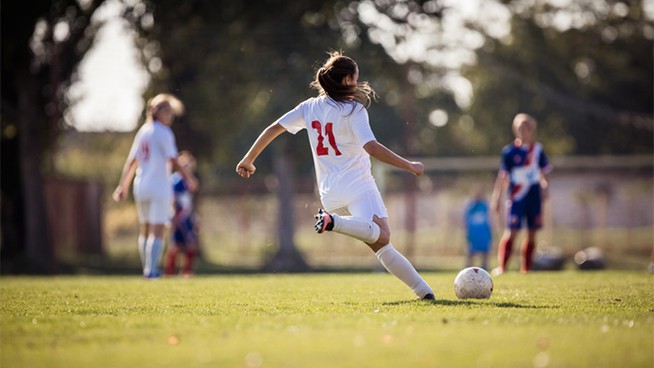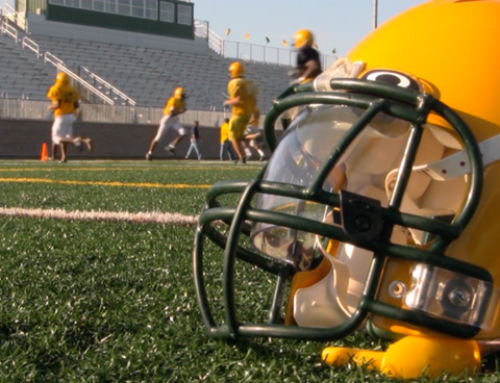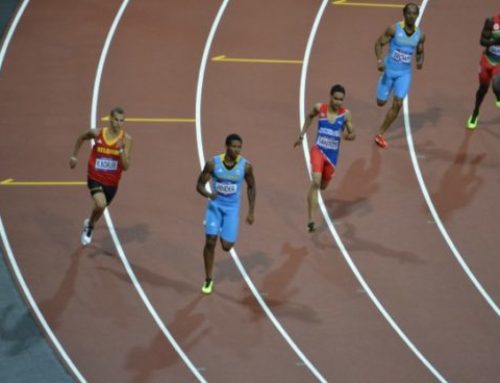6 Truths About Getting Faster
Everyone wants to be faster. To run fast is an empowering thing. Like anything in life, it has to start with belief and be backed by thoughtful practice. I don’t know what your potential is, but I know it’s big and you are likely nowhere close to it.
So it’s time to get after it.
There are only two ways to develop speed when you break it down to its core components:
- Increase the length of your stride
- Increase the frequency of your stride
When you think about stride frequency, think about the kid in grade school with the fastest legs. More often than not, this was the fastest kid at this point in the athlete’s development. Do you remember if it was one of the shorter kids who could move his legs super fast?
And this leads me to our first getting faster truth.
Get Faster Truth 1
Dr. Anatoliy Bondarchuk, a 1972 Olympic gold medalist and author of the two-volume book Transfer of Training, stated that athletes from the age of 6-7 and 12 -14 respond to speed training the best—their systems are plastic and their muscle fibers can be influenced the most during this age. While movements that encourage slow-twitch muscle fibers will hinder the ability to develop fast twitch, the nervous system adapts. So the moral of the story: keep your kids out of long-distance stuff at these ages if you want them to be fast.
I’ve seen countless real world evidence of this. The kids who were sprinting at these ages can turn and burn when it comes to stride frequency which leads us to our next getting faster truth.
Get Faster Truth 2
The way you train is the way your muscles and nervous system adapt, and a 5-mile run sucks for developing speed.
Let’s take this further.
If I had two 12-year-olds of equal speed and experience, I could train one in speed/sprint training and he would beat the other in a 5k if the other kid trained exclusively doing long distance. There are so many benefits to this type of training, especially for kids.
Get Faster Truth 3
Stride frequency is most important for training before kids hit puberty. At this time the CNS (or central nervous system) is still developing and can be molded like clay. This is the best time to introduce kids to multiple sports—non-specialized movement patterns. It is counter-productive for kids to play just one sport, as they do not develop multiple movement patterns, and this will possibly hinder them later in life.
Examples of things to enroll your kids in:
- Gymnastics – explosive, develops ATP-CP system
- Martial arts – explosive
- Soccer – explosive bouts of cutting combined with aerobic system development
- Dance – learning inefficient movements hones the nervous system
- Baseball (sprinting)
- Playing tag with friends – (sprinting)
RELATED: Want to learn more about the three systems of the body? Read more here.
Get Faster Truth 4
Stride frequency cannot be trained after puberty. You are wasting your time after puberty if you are trying to increase it through parachute training or some gimmick. You’ll want to shift your focus to stride length at the high school, college, olympic level or older.
Get Faster Truth 5
You’ll find at this point the fastest individuals are the ones who take the fewest steps.
Like Usain Bolt. Bolt takes 3-5 fewer steps than anyone else in the 100m. Taking fewer steps is faster.
And practically speaking, the majority of improvement in 10-yard sprint times involves taking fewer steps at the beginning of the movement. Which are essentially improvements in acceleration, deceleration and re-acceleration, with most of your progress lying with acceleration.
There are 2 ways to improve stride length:
1. Increase relative strength—the stronger you are in relationship to your body the faster you will be.
If I can Split Squat 200 pounds, I can apply 200 pounds of force into the ground when sprinting, also known as increasing the horsepower!
One of the mistakes I see when people try to improve their speed is when they start doing a lot of sprinting and plyometrics and don’t have the relative strength. They see a little bit of gain initially, but don’t have the joint integrity. A lot of improvement in speed happens in the weight room. You are leaving a lot out if you are disregarding weight training.
2. Increase flexibility, mobility and stability
Flexibility in the hip flexors is huge! If you can’t fully extend your hip how can you apply the most force? When your hip extends is when the glutes are maximally contracted and you are able to apply the most force to the ground. If you have insufficient range of motion in the hip flexors because you sit at a desk all day or spend your time playing video games in a seated position, you are encouraging these muscles to shorten and you are losing power. You are applying only 80% of your maximum if you can’t fully extend the hip!
Unfortunately, I see this a lot in runners who come to train with us in the gym. Everyone is way too tight with overactive hip flexors, tight ankles and glutes turned off.
Functional mobility is defined as the ability to move unrestricted by the stiffness of your joints.
Do you have functional mobility?
Do you have the joint stability to hold your joints in place under stress? Do you have the core stability to hold your hip complex in a neutral spine, so that the glutes can turn on maximally?
Do you sit at a desk all day? Are you stiff in the upper back/thoracic spine?
If you are, how do you expect to get max arm swing to aid you in your speed?
Posture is vital; your grandma was right.
We need to be able to get into the positions to make us fast (neutral spine) and the strength and joint integrity to hold those positions.
This posture thing doesn’t seem like a big deal – BUT IT IS THE BIGGEST DEAL. It connects everything!
Get Faster Truth 6
If you are too weak and immobile to get into these positions, you will never achieve your speed potential. If you lack the movement capability and foundational strength, you won’t be able to get faster because of an inability to get in those positions and produce force.
Your Formula for Rapid Acceleration
- Improve relative strength. Relative strength is the amount of strength to body size, or how strong you are for your size. This reflects a person’s ability to control or move their body through space. The stronger you can get for you (don’t worry about anyone else), the faster you will get as you are able to exhibit a greater ground reaction force in each stride and thus create a longer stride.
- Exercises like Squats, Deadlifts, Power Cleans and Lunges are a good place to start with 5 x 5 set/rep protocols.
- Improve mobility and stability at appropriate positions (ankle, knee, hip and upper back). This can be accomplished by working full range of motion in exercises, focussing more on the muscles you can’t see in the mirror (the posterior chain), and not neglecting mobility.
At the end of the day, you have to put the work in and you have to believe in yourself. Sprinting is a high brain activity—if you have to think too much you won’t run your fastest. If you put the work in regularly in the gym with strength training and mobility it will transfer to the track or the playing field.
Photo Credit: mel-nik/iStock
READ MORE:
RECOMMENDED FOR YOU
MOST POPULAR
6 Truths About Getting Faster
Everyone wants to be faster. To run fast is an empowering thing. Like anything in life, it has to start with belief and be backed by thoughtful practice. I don’t know what your potential is, but I know it’s big and you are likely nowhere close to it.
So it’s time to get after it.
There are only two ways to develop speed when you break it down to its core components:
- Increase the length of your stride
- Increase the frequency of your stride
When you think about stride frequency, think about the kid in grade school with the fastest legs. More often than not, this was the fastest kid at this point in the athlete’s development. Do you remember if it was one of the shorter kids who could move his legs super fast?
And this leads me to our first getting faster truth.
Get Faster Truth 1
Dr. Anatoliy Bondarchuk, a 1972 Olympic gold medalist and author of the two-volume book Transfer of Training, stated that athletes from the age of 6-7 and 12 -14 respond to speed training the best—their systems are plastic and their muscle fibers can be influenced the most during this age. While movements that encourage slow-twitch muscle fibers will hinder the ability to develop fast twitch, the nervous system adapts. So the moral of the story: keep your kids out of long-distance stuff at these ages if you want them to be fast.
I’ve seen countless real world evidence of this. The kids who were sprinting at these ages can turn and burn when it comes to stride frequency which leads us to our next getting faster truth.
Get Faster Truth 2
The way you train is the way your muscles and nervous system adapt, and a 5-mile run sucks for developing speed.
Let’s take this further.
If I had two 12-year-olds of equal speed and experience, I could train one in speed/sprint training and he would beat the other in a 5k if the other kid trained exclusively doing long distance. There are so many benefits to this type of training, especially for kids.
Get Faster Truth 3
Stride frequency is most important for training before kids hit puberty. At this time the CNS (or central nervous system) is still developing and can be molded like clay. This is the best time to introduce kids to multiple sports—non-specialized movement patterns. It is counter-productive for kids to play just one sport, as they do not develop multiple movement patterns, and this will possibly hinder them later in life.
Examples of things to enroll your kids in:
- Gymnastics – explosive, develops ATP-CP system
- Martial arts – explosive
- Soccer – explosive bouts of cutting combined with aerobic system development
- Dance – learning inefficient movements hones the nervous system
- Baseball (sprinting)
- Playing tag with friends – (sprinting)
RELATED: Want to learn more about the three systems of the body? Read more here.
Get Faster Truth 4
Stride frequency cannot be trained after puberty. You are wasting your time after puberty if you are trying to increase it through parachute training or some gimmick. You’ll want to shift your focus to stride length at the high school, college, olympic level or older.
Get Faster Truth 5
You’ll find at this point the fastest individuals are the ones who take the fewest steps.
Like Usain Bolt. Bolt takes 3-5 fewer steps than anyone else in the 100m. Taking fewer steps is faster.
And practically speaking, the majority of improvement in 10-yard sprint times involves taking fewer steps at the beginning of the movement. Which are essentially improvements in acceleration, deceleration and re-acceleration, with most of your progress lying with acceleration.
There are 2 ways to improve stride length:
1. Increase relative strength—the stronger you are in relationship to your body the faster you will be.
If I can Split Squat 200 pounds, I can apply 200 pounds of force into the ground when sprinting, also known as increasing the horsepower!
One of the mistakes I see when people try to improve their speed is when they start doing a lot of sprinting and plyometrics and don’t have the relative strength. They see a little bit of gain initially, but don’t have the joint integrity. A lot of improvement in speed happens in the weight room. You are leaving a lot out if you are disregarding weight training.
2. Increase flexibility, mobility and stability
Flexibility in the hip flexors is huge! If you can’t fully extend your hip how can you apply the most force? When your hip extends is when the glutes are maximally contracted and you are able to apply the most force to the ground. If you have insufficient range of motion in the hip flexors because you sit at a desk all day or spend your time playing video games in a seated position, you are encouraging these muscles to shorten and you are losing power. You are applying only 80% of your maximum if you can’t fully extend the hip!
Unfortunately, I see this a lot in runners who come to train with us in the gym. Everyone is way too tight with overactive hip flexors, tight ankles and glutes turned off.
Functional mobility is defined as the ability to move unrestricted by the stiffness of your joints.
Do you have functional mobility?
Do you have the joint stability to hold your joints in place under stress? Do you have the core stability to hold your hip complex in a neutral spine, so that the glutes can turn on maximally?
Do you sit at a desk all day? Are you stiff in the upper back/thoracic spine?
If you are, how do you expect to get max arm swing to aid you in your speed?
Posture is vital; your grandma was right.
We need to be able to get into the positions to make us fast (neutral spine) and the strength and joint integrity to hold those positions.
This posture thing doesn’t seem like a big deal – BUT IT IS THE BIGGEST DEAL. It connects everything!
Get Faster Truth 6
If you are too weak and immobile to get into these positions, you will never achieve your speed potential. If you lack the movement capability and foundational strength, you won’t be able to get faster because of an inability to get in those positions and produce force.
Your Formula for Rapid Acceleration
- Improve relative strength. Relative strength is the amount of strength to body size, or how strong you are for your size. This reflects a person’s ability to control or move their body through space. The stronger you can get for you (don’t worry about anyone else), the faster you will get as you are able to exhibit a greater ground reaction force in each stride and thus create a longer stride.
- Exercises like Squats, Deadlifts, Power Cleans and Lunges are a good place to start with 5 x 5 set/rep protocols.
- Improve mobility and stability at appropriate positions (ankle, knee, hip and upper back). This can be accomplished by working full range of motion in exercises, focussing more on the muscles you can’t see in the mirror (the posterior chain), and not neglecting mobility.
At the end of the day, you have to put the work in and you have to believe in yourself. Sprinting is a high brain activity—if you have to think too much you won’t run your fastest. If you put the work in regularly in the gym with strength training and mobility it will transfer to the track or the playing field.
Photo Credit: mel-nik/iStock
READ MORE:












